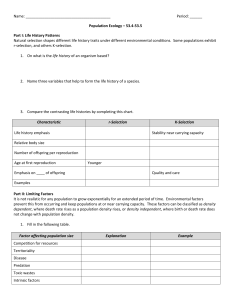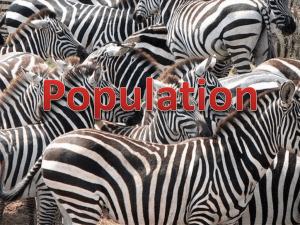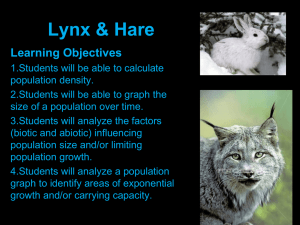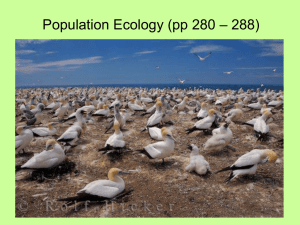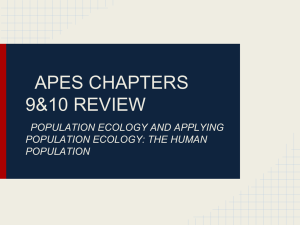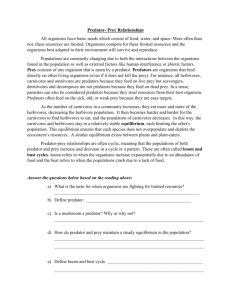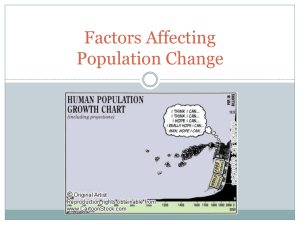Practice Exam
advertisement
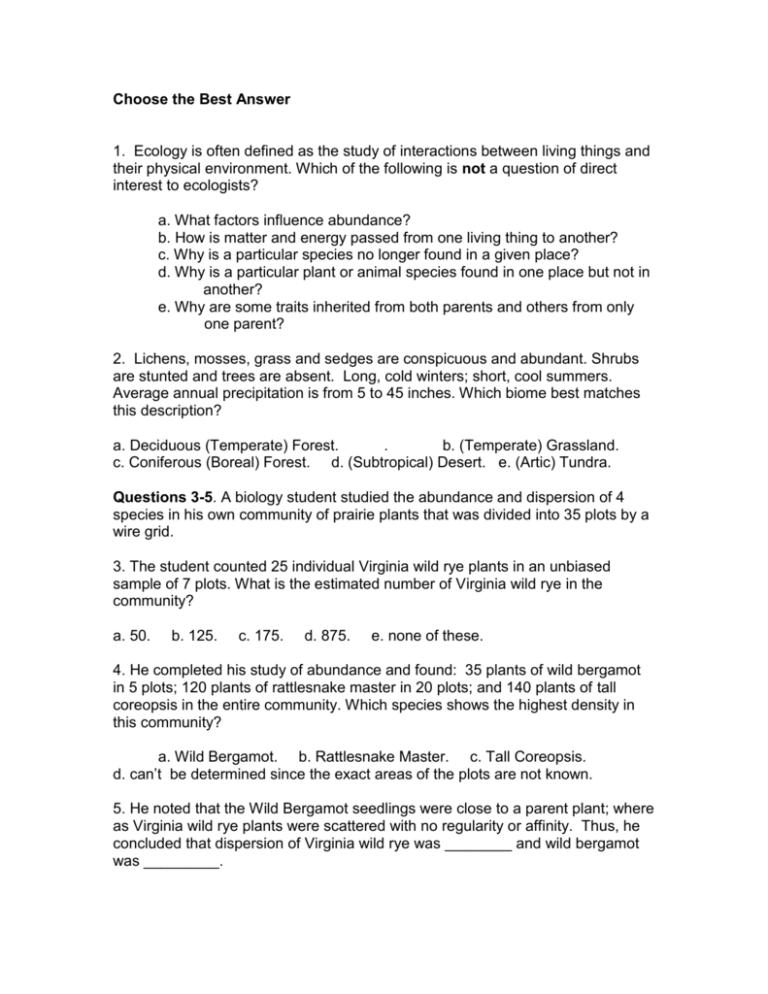
Choose the Best Answer 1. Ecology is often defined as the study of interactions between living things and their physical environment. Which of the following is not a question of direct interest to ecologists? a. What factors influence abundance? b. How is matter and energy passed from one living thing to another? c. Why is a particular species no longer found in a given place? d. Why is a particular plant or animal species found in one place but not in another? e. Why are some traits inherited from both parents and others from only one parent? 2. Lichens, mosses, grass and sedges are conspicuous and abundant. Shrubs are stunted and trees are absent. Long, cold winters; short, cool summers. Average annual precipitation is from 5 to 45 inches. Which biome best matches this description? a. Deciduous (Temperate) Forest. . b. (Temperate) Grassland. c. Coniferous (Boreal) Forest. d. (Subtropical) Desert. e. (Artic) Tundra. Questions 3-5. A biology student studied the abundance and dispersion of 4 species in his own community of prairie plants that was divided into 35 plots by a wire grid. 3. The student counted 25 individual Virginia wild rye plants in an unbiased sample of 7 plots. What is the estimated number of Virginia wild rye in the community? a. 50. b. 125. c. 175. d. 875. e. none of these. 4. He completed his study of abundance and found: 35 plants of wild bergamot in 5 plots; 120 plants of rattlesnake master in 20 plots; and 140 plants of tall coreopsis in the entire community. Which species shows the highest density in this community? a. Wild Bergamot. b. Rattlesnake Master. c. Tall Coreopsis. d. can’t be determined since the exact areas of the plots are not known. 5. He noted that the Wild Bergamot seedlings were close to a parent plant; where as Virginia wild rye plants were scattered with no regularity or affinity. Thus, he concluded that dispersion of Virginia wild rye was ________ and wild bergamot was _________. a. uniform; random. b. random; clumped. c. clumped; uniform. d. clumped; random. e. uniform; clumped. 6. 185 whooping cranes were counted in 2002 and a record population of 189 was counted in 2003. What was the finite rate of increase ()? a. -0.022 b. 0.978 c. 1.021 d. 2.659 e. 4 7. A biologist decided to estimate how many largemouth bass were present in Joe’s pond. He caught and marked 50 largemouth's and returned them to the pond. Two days later he captured 90 bass of which 30 were marked. Assuming that the sampling technique was not biased, how many largemouth bass are likely to be living in the pond? a. 110 b. 150 c. 170 d. 250 e. none of these Questions 8 & 9. A biology student studied a population of woodcocks in a 40acre savanna. In 1990, she determined that natality was 55 per year, mortality 45 per year, immigration 15 per year, and emigration 5 per year. 8. If the initial population in 1990 was 20 woodcocks, what was the population size at the end of the year? a. 35 b. 40 c. 45 d. 50 e. none of these 9. In 1993, the population increased from 30 to 50. How does the finite rate of increase () in 1990 compare with that in 1993? a. was greater in 1993. c. Both are the same. b. was greater in 1990. d. Can’t be determined. Questions 10 & 11 refer to a population of duckweed (Lemna) that inhabits an aquarium. A student interested in studying exponential population growth placed 10 plants in the aquarium. A week later she returned and counted 20 plants. The following week there were 40 plants. 10. Assuming that growth continues at this rate, how many plants will be present in another two weeks? a. 60 b. 80 c. 160 d. 320 e. 640 11. Since she had no way of counting all the plants when their numbers reached more than a thousand, she simply estimated the proportion of the water surface that was covered with duckweed. She determined that the aquarium was covered with duckweed in 22 weeks. Assuming the growth rate she observed in her earlier experiment applies, when was the aquarium half covered? a. 11 weeks. b. 17 weeks. c. 20 weeks. d. 21 weeks. 12. In humans and other species with high survivorship in most age classes, rates of population growth are extremely sensitive to changes in age-specific fecundity. Based on this result, programs to control human population growth focus on: a. Increasing mortality among the earliest age classes. b. Lowering fertility rates through the use of birth control. c. Delaying the age of first reproduction by improving access to education. d. Both a and b are correct. e. Both b and c are correct. Questions 13 - 15. The population data for the human species, as well as six geographical regions of the earth, is given below. This data is for mid-2004 as reported by Population Reference Bureau. Population estimate Rate of natural increase Doubling time (In millions) (% Per year) (years) World Africa North America Latin America Asia Europe Oceania 6,396 885 326 540 3,875 728 31 1.3 2.4 0.5 1.7 1.3 - 0.2 1.0 53 29 139 41 53 ---62 13. The almost impossible rate of growth humankind is experiencing today is seen by projecting out nearly 100 years into the future. If this doubling time is maintained, the projected human population in the year 2110 will be over: a. 7 billion. b. 12 billion. c. 24 billion. d. 48 billion. e. 96 billion. 14. The doubling time for Africa is 29 years and the doubling time for Latin America is 41 years. As a consequence of this difference in doubling times, which statement is true? a. Africa has a larger population. b. Latin America has a larger population. c. The average age in Africa is more than Latin America. d. The average age in Latin America is more than Africa. 15. Based on the above data the population of Asia is expected to increase in a year (mid-2004 --> mid-2005) by about: a. 5,040,000 b. 50,400,000 c. 504,000,000 d. 5,040,000,000 16. The concept of demographic transition illustrates how changes in birth rates and death rates have given rise to increased population growth in many countries during the last century. For example, the population growth rate in Mexico increased dramatically from 1930 through 1970. This is primarily due to a: a. greater increase in per capita birth rate. b. greater increase in per capita death rate. c. greater decrease in per capita death rate. d. greater decrease in per capita birth rate. 17. If most individuals in a population are young, why is the population likely to grow rapidly in the future? a. Many individuals will begin to reproduce soon. b. The population has a skewed age distribution. c. Immigration and emigration can be ignored. d. Death rates will be low. 18. A student in laboratory used data from the Waldeim-Forest Home Cemetery to compare survivorship around the turn of the century (1890-1920) with that near the end of the century (1960-1990). The data indicated that mortality at an early age (0-20 years) was: a. lower in 1890-1920. b. lower in 1960-1990 c. same in both time periods Questions 19 & 20 refer to the following survivorship curves. Each curve may be used once, more than once, or not at all. a. Type I Survivorship. Very low mortality early in life that abruptly increases to a very high level at the end of the life span. b. Type II Survivorship. A constant mortality rate through the life span. c. Type III Survivorship. Very high mortality early in life with low mortality in late life. 19. ______ is the survivorship pattern for long-lived tree populations that have many ungerminated seeds and small seedlings or saplings and that once mature are protected by large size with little chance of death. 20. Most mortality is senescent mortality. This is the goal of public health. ______ 21. Whooping cranes, sea turtles, and many other endangered species are _______ lived and have _____ adult mortality, and _____ fecundity. a. short, low, low b. short, high, high. c. long, low, low. d. long, high, high. e. long, low, high. Questions 22 - 24 refer to the maternity table for a Uinta ground squirrel population in a lawn in Utah. x D(x) S(x) l(x) m(x) l(x)m(x) 0-1 1-2 2-3 3-4 4-5 5-6 6-7 7 ? 169 101 48 22 10 9 1000 359 190 89 41 19 9 0 1.000 0.359 ? 0.089 0.041 0.019 0.009 0 1.75 2.76 2.76 2.76 2.76 2.76 0 0.628 0.524 ? 0.113 0.052 0.025 0 22. How many ground squirrels died before their first birthday, i.e. what is D(0)? a. 100 b. 169 c. 359 d. 641 e. 810 23. What is the net reproductive rate, i.e. what is Ro? a. 1.34 b. 1.58 c. 1.75 d. 2.76 e. 15.55 24. If all Uinta ground squirrels 4 years old and older were removed before they could reproduce, the population would immediately decline and then: a. decrease slowly to extinction. b. decrease rapidly to extinction. c. increase more rapidly than before. d. increase less rapidly than before. e. remains relatively unchanged. 25. A number of European countries such as Poland, Austria, Greece and Portugal have birth rates equal to death rates. If this trend continues then the age structures should have: a. age groups that are relatively uniform in number. b. a high proportion of younger relative to older age groups. c. a high proportion of older relative to younger age groups. d. a large number of individuals who are 100 years old or older. e. very few middle aged individuals (those between the age 35-55). Questions 26 - 28. Populations interact with one another . Five categories of interaction are: a. competition b. mutualism c. predation d. commensalism e. parasitism The above categories may be used once, more than once, or not at all. 26. A population interaction in which one population is benefited and the other is not affected. 27. The roots of some legume species are infected by nitrogen fixing bacteria. The bacteria are provided sugars and other nutrients. The plants are able to use some of the nitrogen fixed by the bacteria. This is an example of _________. 28. A primary cause of the population cycles of the red grouse in British moorlands. 29. Rhizobium, a prokaryote forming nodules in legumes, is primarily associated with: a. nitrogen fixation. e. plant disease. b. denitrification. c. ammonification. d. decomposition. 30. The observation that per plant biomass is higher when Indian Grass is grown at low density rather than high density is most likely an example of __________. a. intraspecific competition. b. interspecific competition. c. intraspecific cooperation. d. interspecific cooperation. 31. How do parasites differ from predators? a. Parasites do not affect the density of their host species, but predators affect thedensity of their prey. b. Parasites tend to be very small relative to their host, and eat only certain tissues. c. Predators kill their prey more quickly and consume all of it. d. Both a and b are correct. e. Both b and c are correct. Questions 32 & 33 refer to studies of the 10 year cycle of snowshoe hare and lynx population in northern Canada. 32. A predator hypothesis states that at high density lynx eat so many hare that the prey population crashes and shortly thereafter many lynx starve. Which of the following observations support this hypothesis? a. 95% of radio-collared snowshoe hare deaths are due to predation. b. Predator exclusion nearly eliminated the decline phase of hare cycle. c. Snowshoe hare populations show same fluctuations on an island where lynxes are absent. d. Both a and b support the predator hypothesis. e. Both b and c support the predator hypothesis. 33. Recently, most population ecologists have reached a consensus that trophic interactions are likely to generate these population cycles. Which of the following best explains these trophic interactions? a. Hare populations are unlimited by food supply and lynx kill more than enough hare to account for the decline. b. Food consumption increases as hare density increases, but all of the available food is consumed and the hare starve; shortly thereafter the lynx starve. c. Lynx populations reach high density in response to increases in hare density; at this density they eat so many hare that the prey population crashes. d. Hare populations increase to such high levels that they run out of food, but by that time the lynx population is so full that they migrate to other areas. 34. In a local old field, white-footed deer mice provide the major food source for a small fox population. This predator-prey interaction has obvious advantages for the fox population. What is the possible advantage for the mouse population? a. Foxes are likely to eat other predators. b. More fox pups are likely to survive when mice are abundant. c. Since foxes eat mice, there is no possible advantage to mouse populations. d. Predation may act to keep mouse populations from exceeding their food supply or some other critical environmental resource. 35. Of the four most abundant elements in living things, which do producers procure directly from the atmosphere? a. H and N b. C and N c. H and O d. C and O e. H and C 36. Net Primary Production (NPP) is highest in: a. Desert. b. Tundra. d. Deciduous Forest. c. Coniferous Forest. e. Grassland. 37. Nitrogen is an important macronutrient and is a major ingredient of “plant food” (fertilizer). Experiments with soil nitrogen and plant biomass indicate that: a. all plant species respond to increased soil nitrogen in exactly the same way. b. plant biomass increases with increases in soil nitrogen and then levels off. c. increasing the amount of fertilizer added to soil increases plant biomass. d. very high levels of nitrogen in the soil result in plants with yellow leaves. e. plants do best when levels of nitrogen in the soil are low. 38. Herbivores are animals that receive most, if not all, of their nutrition from plants. Much of recent research on herbivory has focused on this question: why don’t herbivores consume more plants than they do. Which of the following is not an explanation that biologists have routinely considered? a. Herbivores commonly kill the plants they eat, thus they could be limiting their own populations. b. Herbivores could be kept in check by predation and disease. c. Plant tissues could offer poor or incomplete nutrition. d. Plants could defend themselves against attach by producing indigestible wood or potent poisons. 39. When the newts are absent in artificial ponds, spade foot toad survival is much higher than spring peepers. When the density of newts increases, spade foot survival is lower than spring peepers. Predation is affecting a second type of species interaction. This interaction is _____________. a. mutualism b. commensalism c. competition d. parasitism e. predation 40. What distinguishes a keystone predator? a. It is extremely abundant. b. It regulates its prey below the carrying capacity of the habitat. c. It is a specialist, meaning that it preys on only one species. d. It has a large impact on the community, even though it is not particularly abundant.
